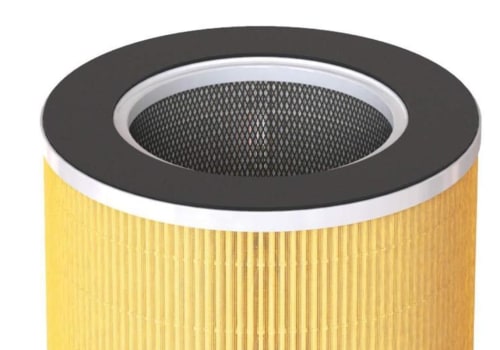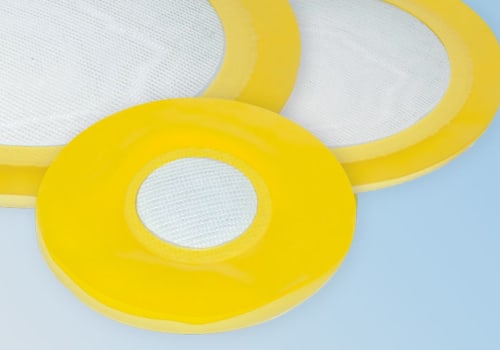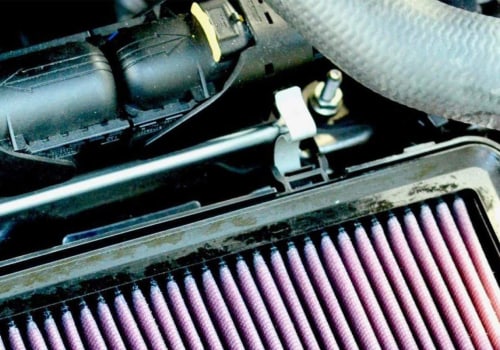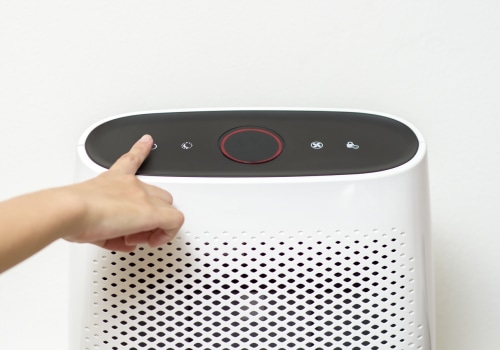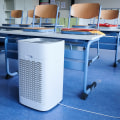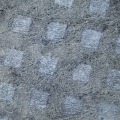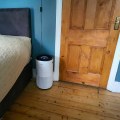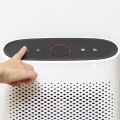Coway AP-1512HH Mighty · Effective, Efficient & Affordable; Finalist. Coway Airmega 200M · Different look, same great performance; Also great. In Auto (similar to medium; the air does not contain a particle counter to adjust to air conditions, but instead asks you to enter the approximate size of your room, after which the machine chooses a fan speed that Molekule deems appropriate), the air performed worse, reducing particles by 0.3 microns at only 18.0% (ambient) and 26.4% (clean). In Silent, it performed even worse, reducing 0.3 micron particles by 6.5% (ambient) and 7.2% (clean).
And in Dark plus Auto, with its primary PECO purification system turned off and its fan at the equivalent of a medium setting, it reduced them by 21.3% (ambient) and 18.0% (clean). Interestingly, those numbers closely reflect our results in automatic configuration with the PECO system activated, suggesting the possibility that the Molekule Air depends mainly on its physical prefilter, not its patented PECO mechanism, to remove particles. Like the Blueair Classic 605, this purifier is one of four air purifiers tested by Consumer Reports for an “Excellent” rating on both the highest and lowest speed settings. Like the other Blueair purifiers, this model uses the brand's HepaSilent technology, which, according to the company, can filter 99.97 percent of particles down to 0.1 microns.
By Steven Asarch, Hope Glendon published 1 August 22, The best air purifiers will help you breathe a little easier at home. Air purifiers are designed to filter essentially any unwanted particles in the air, such as dust, pollen and smoke. Some models even claim that they help protect against the coronavirus COVID-19 by filtering airborne particles that carry the virus, according to Consumer Reports, this is the reason these devices skyrocketed in popularity during the pandemic. By filtering the air, air purifiers promote a healthier breathing environment, reducing allergy and asthma symptoms.
With charcoal filters, these appliances are also natural deodorants, making them ideal in the kitchen. However, most tend to store them in the bedroom, to help them sleep better at night. After testing 10 models, both in the laboratory and at home, we believe that the Blueair Blue Pure 211+ Auto is the ultimate air purifier, combining quality, efficiency and value in one elegant package. It surprised us with how effectively it cleaned the air in a room, without being annoying.
If you buy on a budget and need an air purifier for a small space, then the BlueAir Blue Pure 411 Auto is unbeatable with its automatic mode, perfect for children's room or office. It's easy to set up and its operation is also quiet, making it ideal for nighttime use. Throughout our tests, one cube-shaped air purifier stood out above the rest. Blueair Blue Pure 211+ Auto dominated the competition.
It has the ability to clean the air in a large room while using minimal power and generating very little noise. It may not be as flashy as its more expensive cousin, the Health Protect 7470i, but it doesn't need the extra expense to get the job done. Designed for large spaces (rooms up to 550 square feet), its average clean air supply rate (CADR) of 360 for smoke, dust and pollen was the highest of any we tested. That means it's fast and efficient at removing pollutants from the air.
The Honeywell HPA300 is a bulky device that offers good value for money considering its impressive performance. It's a large oval air purifier with slats around it, which makes it look like it belongs in the office of a dystopian future. It's also quite heavy, weighing 17 pounds, so this is the type of air purifier you won't want to move once you put it in. A truly powerful device, the HPA300 ranked second in the CADR test, behind the Blueair Blue Pure 211+ auto, with its three filters capable of removing most contaminants in a large 465-square-foot room.
With an average CADR score of 306, it performed slightly better on dust than on pollen and smoke. Replacement filters are very reasonably priced and only need to be changed every 12 months. It's noisier and has a higher energy output compared to others on the list, but the purification capabilities make it easy to overlook, which is why it's one of the best air purifiers. The most expensive and heaviest air purifier we tested is also one of the best air purifiers.
It can clean a room of contaminants efficiently, increasing its resistance relatively easily when needed. With two lights in the front, one representing gas pollutants and the other for larger particles, Blueair Health Protect 7470i has the clearest indicator of air quality we've seen on any of the devices. Every time we started cooking, those lights would turn bright red and the fan would go into overdrive. The weight of this air purifier makes it a bit cumbersome when trying to move it to different rooms, but it's the only device we tested that includes a pair of wheels to help with this.
Even though it's the quietest of the bunch, it's also worth mentioning that it tends to consume more energy than other devices at 0.241 kWh in 24 hours, so all that data comes at a cost. The recommended room size for this model is slightly smaller than its sibling, the 211+ Auto, but it still performs well in a fairly large living space of approximately 418 square feet. It had an average CADR score of 275, performing better on pollen compared to dust and smoke. If you want a quality air purifier and you don't mind the high price, we recommend the Blueair Health Protect 7470i.
It's an ideal purchase if you want to see the impact your air purifier is having in real time. It received an average CADR of 240, with similar performance in dust, smoke and pollen, and would fit a room size of 384 square feet. It's a pretty strong performance considering its compact design. The Winix 5500-2 performed well, only below some of the others on our list.
It is the only device that uses the relatively unknown “Plasmawave” technology. The premise behind this is that it creates hydroxyls that easily bind to other molecules to neutralize air faster. It received an average CADR score of 240 as a result, roughly the same as the Coway Airmega, and would fit rooms up to 360 square feet. The Blueair Blue Pure 411 Auto small air purifier is ideal for any small room, up to 190 square feet.
He doesn't have the same strength or style as his two older siblings, but that doesn't make it any less worthwhile. It's a cute little device and still manages to pack in multiple layers of filtration to keep the air clean. It uses the same simplistic yet easy to use controls as the 211+ Auto, which means you won't have any problems trying to set it up or start it. Simply attach it directly to the wall and choose the setting you want by touching its small head.
It didn't score as high on CADR tests compared to many of the other devices, it only scored an average score of 109, but it's specifically designed for smaller spaces, so it's not necessarily a bad thing. It may not clean the air in the entire house, but it should work wonders in small bedrooms or small spaces. Tom's Guide put 10 air purifiers through rigorous months of testing to build this list. First, we compare the CADR of each to get an accurate representation of performance.
If the manufacturer did not provide a CADR rating, we send it to a laboratory to obtain our own rating; we use SGS IBR laboratories for this test. The laboratory calculated the CADR for each pollutant using the AHAM AC-1 test method, which involves placing each air cleaner in a test chamber and measuring the rate at which it reduces dust, smoke and pollen from the atmosphere. Once you have these figures, you can calculate the recommended room size for the air purifier. We then ran a separate home test to compare the design and ease of use of each air purifier in a real environment.
To get power, we connect each device to an electricity consumption monitor and run it for a full 24 hours. To calculate the noise output, we used a decibel meter and set the purifiers at a set distance of three feet apart, both at the lowest and highest possible fan settings. We also did an environmental reading to make sure that the fan noise wasn't dominated by the outside world. Government agencies and professional groups, including the EPA and the American Lung Association, recommend True HEPA filters as a standard for air purification.
These filters trap 99.97% of particles with a minimum size of 0.3 microns. Some modern air purifiers, such as the Blueair Health Protect 7470i, can connect to the Wi-Fi network and link to an application on your smartphone. By doing so, you can control the air cleaner remotely, including changing the fan speed or setting a schedule. For some air purifiers, the app will also analyze the air quality and allow you to control it more precisely.
In its Boost configuration, when it was moving the maximum amount of air, the air could reduce 0.3 micron particles by 61.3% under ambient starting conditions and 57.0% under clean starting conditions. Choosing an air purifier with more coverage area than the exact size of your room will allow you to use it in a lower consumption mode or increase the number of clean air changes per hour. We like other Blueair products, and this one adds cool air to its purification capabilities: it cycles air five times an hour in a 326 square foot room. This air purifier excels when it comes to dust and odor eradication, with a pre-filter and an odorization filter to reduce pollutants in the air.
These ionized air molecules then, in theory, bind to airborne particles and give them a charge, encouraging them to bind and create larger particles that may be easier to filter or large enough to deposit in air. In addition to buying an air purifier, there are some good home habits you can adopt to help reduce the amount of air pollution in your space. Air purifiers are designed to eliminate indoor air pollution from cooking, car emissions, dust and fire, among other things. We ruled out air purifiers that rely on ozone (O3, a molecule composed of three oxygen atoms) to “purify the air”.
While I generally consider HEPA to be the best, a good HEPA filter doesn't mean that the air purifier necessarily works well. In fact, our years of testing have shown that any properly sized purifier will distribute filtered air evenly, in the farthest corner of a room. Its redesigned filtration system makes the entire machine compliant with the HEPA H13 standard, not just the filter, the air purifier can capture 99.97 percent of particles that are as small as 0.3 microns. Purifiers work best in an adjoining space; if you want to clean the air in both the living room and bedroom, for example, it's best to buy a purifier for each room or move a single purifier with you.
To change the filter, unscrew the fan component from the air cleaner, then remove the washable cloth pre-filter cover from the filter. . .
best air filters